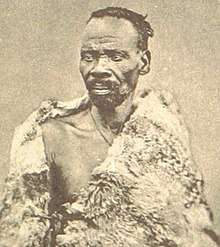Sekukuni
Matsebe Sekukuni[lower-alpha 1] (1814 – 13 August 1882) was king of the Pedi people in Sekhukhuneland, in the present-day South African province of Limpopo.
| Sekukuni I | |
|---|---|
 | |
| King of the Pedi people | |
| Reign | 21 September 1861 – 13 August 1882 |
| Successor | SekukuniII |
| Born | Matsebe Sekukuni Unknown date, 1814 |
| Died | (aged 68) |
| Father | King Sekwati |
| Mother | Thorometjane Phala |
He became king upon the death of his father, King Sekwati, in September 1861. Sekukuni married Legoadi IV in 1862, and lived at a mountain, now known as Thaba Ya Leolo,[1] which he fortified.
As the Bapedi paramount leader he was faced with political challenges from the Boers, the independent South African Republic and the British Empire, with considerable social change caused by Christian missionaries.[2]
He fought two wars. The first war was successfully fought in 1876, against the ZAR and their Swazi allies. The second war, against the British and Swazi in 1879 in what became known as the Sekukuni Wars, was less successful.[2][3]
Sekukuni was detained in Pretoria until 1881. After a return to his kingdom, he was fatally stabbed by an assassin in 1882. The assassins are presumed to have been sent by his brother and competitor, Mampuru II.[4][5]
Footnotes
- sometimes spelled Sekhukhune
- Du Plessis, E. J. (1973). 'n Ondersoek na die oorsprong en betekenis van Suid-Afrikaanse berg- en riviername: 'n histories-taalkundige studie [An Investigation into the origin and meaning of South African mountain and river names: a historico-linguistic study] (in Afrikaans). Cape Town: Tafelberg. p. 187. ISBN 978-0-624-00273-4.
- "King Sekhukhune". South African History Online. 13 February 2018. Retrieved 4 March 2019.
- Kinsey, H.W. (June 1973). "The Sekukuni Wars". Military History Journal. The South African Military History Society. 2 (5).
- Delius, Peter (1984). The land belongs to us: the Pedi polity, the Boers and the British in the nineteenth-century Transvaal. Heinemann. pp. 251–252. ISBN 978-0-435-94050-8.
- Delius, Peter; Rüther, Kirsten (2013). "The King, the Missionary and the Missionary's Daughter". Journal of Southern African Studies. 39: 597–614. doi:10.1080/03057070.2013.824769.
Further reading
- Mabale, Dolphin (18 May 2017). Contested Cultural Heritage in the Limpopo Province of South Africa: the case study of the Statue of King Nghunghunyani (MA). University of Venda. hdl:11602/692.CS1 maint: ref=harv (link)
- Motseo, Thapelo (22 August 2018). "King Sekhukhune I colourfully remembered". sekhukhunetimes.co.za. Retrieved 4 March 2019.